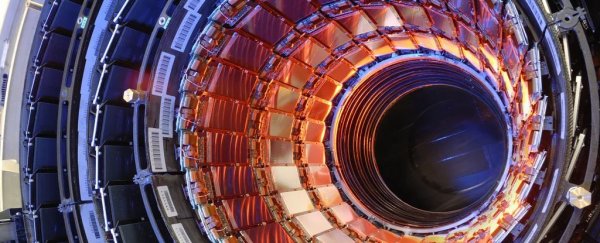A mysterious particle thought to have existed briefly just after the Big Bang has now been detected for the first time in the 'primordial soup'.
Specifically, in a medium called the quark-gluon plasma, generated in the Large Hadron Collider by colliding lead ions. There, amid the trillions of particles produced by these collisions, physicists managed to tease out 100 of the exotic motes known as X particles.
"This is just the start of the story," says physicist Yen-Jie Lee of MIT, and a member of the international CMS Collaboration headquartered at CERN in Switzerland.
"We've shown we can find a signal. In the next few years we want to use the quark-gluon plasma to probe the X particle's internal structure, which could change our view of what kind of material the Universe should produce."
Mere moments after the Big Bang, the very early Universe wasn't made of the same stuff we see floating around today. Instead, for a few millionths of a second, it was filled with plasma superheated to trillions of degrees, consisting of elementary particles called quarks and gluons. That's the quark-gluon plasma.
In less time than it takes to blink, the plasma cooled and the particles came together to form the protons and neutrons of which normal matter is constructed today. But in that very brief twitch of time, the particles in the quark-gluon plasma collided, stuck together, and came apart again in different configurations.
One of those configurations is a particle so mysterious, we don't even know how it's put together. This is the X particle, and it's only been seen very rarely and briefly in particle colliders – too briefly to be probed.
Theoretically, however, X particles could appear in the very small flashes of quark-gluon plasma that physicists have been creating in particle accelerators for some years now. And this might afford a better opportunity to understand them.
During the Large Hadron Collider's 2018 run, positively charged atoms of lead (lead ions) were slammed together at high speeds. Each of these roughly 13 billion collisions produced a shower of tens of thousands of particles. That's a dauntingly colossal amount of data to sift through.
"Theoretically speaking, there are so many quarks and gluons in the plasma that the production of X particles should be enhanced," Lee says. "But people thought it would be too difficult to search for them because there are so many other particles produced in this quark soup."
Although X particles are very short-lived, when they decay, they produce a shower of lower-mass particles. To streamline the data analysis process, the team developed an algorithm to recognize the patterns characteristic of X particle decay. Then they fed the 2018 LHC data into their software.
The algorithm identified a signal at a specific mass that indicated the presence of around 100 X particles in the data. This is an excellent start.
"It's almost unthinkable that we can tease out these 100 particles from this huge dataset," Lee said.
At this point, the data are insufficient to learn more about the X-particle's structure, but the discovery could bring us closer. Now that we know how to find the X-particle's signature, teasing it out in future data sets should be a lot easier. In turn, the more data we have available, the easier it will be to make sense of them.
Protons and neutrons are each made up of three quarks. Physicists believe that X particles may be made of four – either an exotic, tightly bound particle known as a tetraquark, or a new kind of loosely bound particle made from two mesons, each of which contain two quarks. If it's the former, because it's more tightly bound, it will decay more slowly than the latter.
"Currently our data is consistent with both because we don't have enough statistics yet. In the next few years we'll take much more data so we can separate these two scenarios," Lee says.
"That will broaden our view of the kinds of particles that were produced abundantly in the early Universe."
The research has been published in Physical Review Letters.
